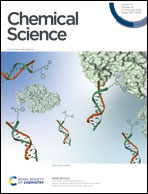Unravelling strong temperature-dependence of JHD in transition metal hydrides: solvation and non-covalent interactions versus temperature-elastic H–H bonds†
Abstract
A number of transition metal hydrides reveal intriguing temperature-dependent JHD in their deuterated derivatives and possibly the temperature dependent hydrogen–hydrogen distance (r(H–H)) as well. Previously, theoretical studies rationalized JHD and r(H–H) changes in such compounds through a “temperature-elastic” structure model with a significant population of vibrational states in an anharmonic potential. Based on the first variable temperature neutron diffraction study of a relevant complex, (p-H-POCOP)IrH2, observation of its elusive counterpart with longer r(H–H), crystallized as an adduct with C6F5I, and thorough spectroscopic and computational study, we argue that the model involving isomeric species in solution at least in some cases is more relevant. The existence of such isomers is enabled or enhanced by solvation and weak non-covalent interactions with solvent, such as halogen or dihydrogen bonds. “Non-classical” hydrides with r(H–H) ≈ 1.0–1.6 Å are especially sensitive to the above-mentioned factors.



 Please wait while we load your content...
Please wait while we load your content...